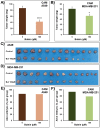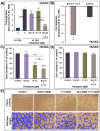Butein and Frondoside-A Combination Exhibits Additive Anti-Cancer Effects on Tumor Cell Viability, Colony Growth, and Invasion and Synergism on Endothelial Cell Migration
- PMID: 35008855
- PMCID: PMC8745659
- DOI: 10.3390/ijms23010431
Butein and Frondoside-A Combination Exhibits Additive Anti-Cancer Effects on Tumor Cell Viability, Colony Growth, and Invasion and Synergism on Endothelial Cell Migration
Abstract
Despite the significant advances in targeted- and immuno-therapies, lung and breast cancer are at the top list of cancer incidence and mortality worldwide as of 2020. Combination therapy consisting of a mixture of different drugs taken at once is currently the main approach in cancer management. Natural compounds are extensively investigated for their promising anti-cancer potential. This study explored the anti-cancer potential of butein, a biologically active flavonoid, on two major solid tumors, namely, A549 lung and MDA-MB-231 breast cancer cells alone and in combination with another natural anti-cancer compound, frondoside-A. We demonstrated that butein decreases A549 and MDA-MB-231 cancer cell viability and colony growth in vitro in addition to tumor growth on chick embryo chorioallantoic membrane (CAM) in vivo without inducing any noticeable toxicity. Additionally, non-toxic concentrations of butein significantly reduced the migration and invasion of both cell lines, suggesting its potential anti-metastatic effect. We showed that butein anti-cancer effects are due, at least in part, to a potent inhibition of STAT3 phosphorylation, leading to PARP cleavage and consequently cell death. Moreover, we demonstrated that combining butein with frondoside-A leads to additive effects on inhibiting A549 and MDA-MB-231 cellular viability, induction of caspase 3/7 activity, inhibition of colony growth, and inhibition of cellular migration and invasion. This combination reached a synergistic effect on the inhibition of HUVECs migration in vitro. Collectively, this study provides sufficient rationale to further carry out animal studies to confirm the relevance of these compounds' combination in cancer therapy.
Keywords: STAT3; angiogenesis; breast cancer; butein; frondoside-A; invasion; lung cancer; tumor growth; viability.
Conflict of interest statement
The authors declare no conflict of interest. The funders had no role in the design of the study; in the collection, analyses, or interpretation of data; in the writing of the manuscript, or in the decision to publish the results.
Figures









Similar articles
-
Frondoside a suppressive effects on lung cancer survival, tumor growth, angiogenesis, invasion, and metastasis.PLoS One. 2013;8(1):e53087. doi: 10.1371/journal.pone.0053087. Epub 2013 Jan 8. PLoS One. 2013. Retraction in: PLoS One. 2023 Sep 8;18(9):e0291478. doi: 10.1371/journal.pone.0291478. PMID: 23308143 Free PMC article. Retracted.
-
Frondoside A inhibits human breast cancer cell survival, migration, invasion and the growth of breast tumor xenografts.Eur J Pharmacol. 2011 Oct 1;668(1-2):25-34. doi: 10.1016/j.ejphar.2011.06.023. Epub 2011 Jun 27. Eur J Pharmacol. 2011. PMID: 21741966
-
Frondoside A Enhances the Anti-Cancer Effects of Oxaliplatin and 5-Fluorouracil on Colon Cancer Cells.Nutrients. 2018 May 1;10(5):560. doi: 10.3390/nu10050560. Nutrients. 2018. PMID: 29724012 Free PMC article.
-
The Anti-Cancer Effects of Frondoside A.Mar Drugs. 2018 Feb 19;16(2):64. doi: 10.3390/md16020064. Mar Drugs. 2018. PMID: 29463049 Free PMC article. Review.
-
Molecular chemotherapeutic potential of butein: A concise review.Food Chem Toxicol. 2018 Feb;112:1-10. doi: 10.1016/j.fct.2017.12.028. Epub 2017 Dec 16. Food Chem Toxicol. 2018. PMID: 29258953 Review.
Cited by
-
Targeting STAT3 and NF-κB Signaling Pathways in Cancer Prevention and Treatment: The Role of Chalcones.Cancers (Basel). 2024 Mar 8;16(6):1092. doi: 10.3390/cancers16061092. Cancers (Basel). 2024. PMID: 38539427 Free PMC article. Review.
-
Anticancer Potential of Natural Chalcones: In Vitro and In Vivo Evidence.Int J Mol Sci. 2023 Jun 19;24(12):10354. doi: 10.3390/ijms241210354. Int J Mol Sci. 2023. PMID: 37373500 Free PMC article. Review.
-
Butein Alleviates Non-Alcoholic Steatohepatitis in Leptin-Deficient Mice by Modulating the PDE4/cAMP/p-CREB Pathway.Drug Des Devel Ther. 2025 Aug 14;19:7015-7031. doi: 10.2147/DDDT.S530855. eCollection 2025. Drug Des Devel Ther. 2025. PMID: 40831700 Free PMC article.
-
Design and Synthesis of Novel α-Methylchalcone Derivatives, Anti-Cervical Cancer Activity, and Reversal of Drug Resistance in HeLa/DDP Cells.Molecules. 2023 Nov 21;28(23):7697. doi: 10.3390/molecules28237697. Molecules. 2023. PMID: 38067428 Free PMC article.
-
Human Non-Small Cell Lung Cancer-Chicken Embryo Chorioallantoic Membrane Tumor Models for Experimental Cancer Treatments.Int J Mol Sci. 2023 Oct 21;24(20):15425. doi: 10.3390/ijms242015425. Int J Mol Sci. 2023. PMID: 37895104 Free PMC article.
References
-
- Balik K., Modrakowska P., Maj M., Kaźmierski Ł., Bajek A. Limitations of molecularly targeted therapy. Med. Res. J. 2019;4:99–105. doi: 10.5603/MRJ.a2019.0016. - DOI
MeSH terms
Substances
LinkOut - more resources
Full Text Sources
Research Materials
Miscellaneous

